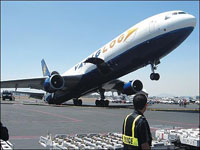 Many pilots, myself included, are surprised to learn of the weight and balance limitations of most general aviation aircraft. Take my training airplane, a Piper Warror, it has four seats, more than enough room for baggage, and can carry 48 gallons of fuel. With it’s stingy fuel burn of six gallons per hour, you can fly over four hours with no problem at all, loaded up with four of your friends for the weekend….right? Not so fast.
Many pilots, myself included, are surprised to learn of the weight and balance limitations of most general aviation aircraft. Take my training airplane, a Piper Warror, it has four seats, more than enough room for baggage, and can carry 48 gallons of fuel. With it’s stingy fuel burn of six gallons per hour, you can fly over four hours with no problem at all, loaded up with four of your friends for the weekend….right? Not so fast.
The cold hard truth is a Warrior is only good for two adults plus baggage or three adults with virtually no bags if you have it filled up. Drop some fuel and you can put a pair of lightweights in the back seat…and that’s pushing it. Add a decent radio stack, A/C, and other options and you’d be pressed to get a Warrior to hold three people.
So why is it called a 4-place airplane? Well, unfortunately, because it DOES have four seats. What this all comes down to is utility. The Warrior is designed for flight training and lightweight personal use — it’s not marketed or intended to pack up the family for the weekend and haul them cross-country. Piper made a PA28 variant for that, the Dakota.
In the aviation forums I frequent, people are always asking what airplane is right for me. The fantastic reality is there are hundreds of airplanes out there to choose from to get what really is right for you.
Let’s take the Piper Cherokee Six, for example. It has six seats, two baggage compartments, four fuel tanks, and a 300 horsepower brute engine up front. The Cherokee Six is designed for utility. It’s not that fast, about 145 knots, it’s not fancy — no retractable gear, and it’s not very efficient, at 16 gallons per hour. But with all that, the Cherokee Six can haul over 1,000lbs of weight AFTER you fill the tanks. That means you really can put six adults in it’s six seats, and still carry some luggage.
Now, let’s say you want to go fast….it’s Meridian time. Single-engine turboprop, 30,000ft ceiling, air stair entry, retractable gear, and enough ramp presence to gain an audience when you walk out. You can cruise around at 260 knots for over four hours, but you can only haul about 600 pounds of people and gear while doing it — so unless you’ve got six really skinny friends, you’ll be hard-pressed to fill the Meridian’s seats.
Ok, that’s all wonderful information, but what does this mean? What this leads to is an unbelievable desire by pilots to overload their airplanes. So what would happen if I put four 200 pound guys in the Warrior, maxed-out the baggage department at 100 pounds, and full tanks? Would it fly? Probably. Would it climb? Most likely. Would I safely get to where I was going? Yeah, I’d say so. So why not do it? Simple, the manufacturer says the plane can hold X number of pounds, they’ve tested the loading, what happens during turbulence, and other flight conditions — and it’s safe. Over that weight, and you’re a test-pilot.
Overloading an aircraft can cause extreme stresses on the wing, landing gear, and other components during takeoff, landing, turbulence, and maneuvers. The structure wasn’t designed to hold that much weight, and there’s no guarantee it will hold together.
So what am I getting at? Read the POH, know the weight limits of your airplane and stick to them. They’re in there for a reason. If you can’t haul four people, deal with it, you can’t. Don’t fly with five minutes of reserve fuel just so you can haul an anvil up to the Coyote’s house. It’s not worth it.Comments? Leave ’em!
